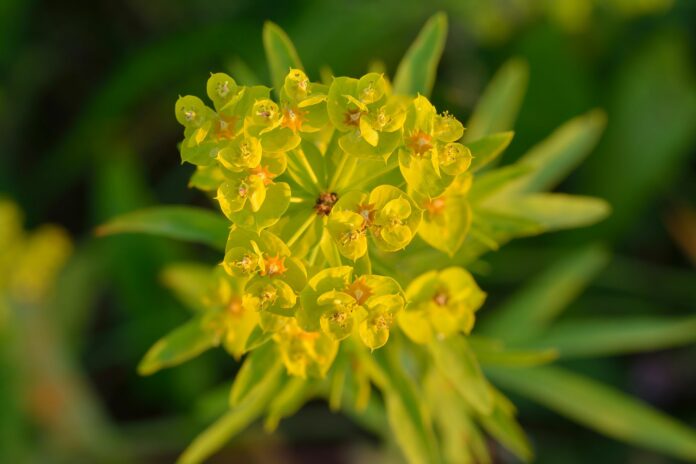
By Blaine Bug Crew
These long hot summer days are the perfect climate for leafy spurge to make its move. While other plants are wilting in the hot summer sun, leafy spurge basks in the sun during drought-like conditions.
This plant is toxic to almost all forms of livestock; however, goats think it is candy. Goat herds are used in the rough Payette drainage to rid the steep hillsides of leafy spurge. When leafy spurge stems are damaged, a milk-like substance exudes from them. One needs to be careful not to get this substance in your eyes as it can be very harmful. This plant is one of the most resilient in the noxious weed realm.
Leafy spurge is a deep-rooted, aggressive, persistent perennial that reproduces vegetatively and by seed. Plants have an extensive root system that grows horizontally and can reach depths of up to 20 feet. Stems are thickly clustered and have narrow, alternate leaves that exude milky latex when damaged. The flowers are small and yellowish-green and are enclosed in showy yellow-green bracts. Seeds are oblong and occur in clusters of three. When the seeds are dry, the capsules shatter and spread the seeds as far as 15 feet from the plant.
Leafy spurge is commonly found in grassland and rangeland habitats and can also invade forests and riparian areas, displacing native vegetation.
Leafy Spurge Flea Beetles (AP): The Apthona sp. Complex consists of six different species, all with similar biology. The larval stage is the most destructive to leafy spurge. AP larvae feed on fine and lateral leafy spurge roots, impairing the roots and preventing moisture and nutrient uptake. Larval root feeding provides entry points for disease.
AP larvae may be found in infested leafy spurge roots from July to early spring of the following year. AP pupates in the soil near the leafy spurge roots, with adult emergence occurring in June, July and August. Adult AP feeding reduces leafy spurge’s ability to make sugars for root reserves. AP is best suited for dry sites with a large amount of sun exposure. Recent studies suggest that AP can also be used as a “bio-herbicide” in riparian areas.
As you can see, we have a weed predator to match this noxious invader. Leafy spurge seems to prefer hot, arid hillsides. That is why our insects are the perfect catalyst to combat this advancing weed. They are actual insects, meaning they have six legs and wings; they have no problem moving from plant to plant and stunting leafy spurge’s growth.
If you encounter a new infestation of leafy spurge while hiking or biking, please get in touch with Kay Draper with the Blaine County Noxious Weed Department at (208) 727-7221.
